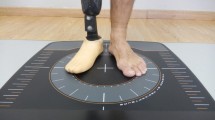Abstract
The main objectives of rehabilitative treatment in the amputee patient are the psychophysical recovery of the patient through protetization and, finally, their socio-labor reintegration. To be able to measure the achievements obtained with the rehabilitative treatment we need to have objective assessment measures (functional assessment scales) that will allow the use of standard terminology. The objective of this study is to review various scales of assessment of the amputee. The scales have been classified as universal (Barthel Index, Pulses Profile, Functional Independence Measure, and Edinburg scale) and specific: for members (Enneking scale and Locomotion Score in Rheumatoid Arthritis) and for amputees (Day scale and the questionnaire Prosthetic Profile of the Amputee). This study seeks to discover the design parameters and the acceptance of the population that uses prosthetic devices and their environment (family, work and health personnel) towards new technologies in terms of prostheses to discover and understand the functioning of the Uncanny Valley in the Ecuadorian environment, to avoid falling into it. The results will be adequately delimited and tabulated by intelligent computer systems.
Access this chapter
Tax calculation will be finalised at checkout
Purchases are for personal use only
Similar content being viewed by others
References
Jarrín Aguirre, D.V.: Diseño del lanzamiento para la marca; Toucher: innovación en prótesis. Universidad San Francisco de Quito (2015)
Buckingham, G., Parr, J., Wood, G., Day, S., Chadwell, A., Head, J., Galpin, A., Kenney, L., Kyberd, P., Gowen, E., Poliakoff, E.: Upper- and lower-limb amputees show reduced levels of eeriness for images of prosthetic hands. Psychon. Bull. Rev. 26(4), 1295–1302 (2019). https://doi.org/10.3758/s13423-019-01612-x
Sansoni, S., Wodehouse, A., McFadyen, A., Buis, A.: The aesthetic appeal of prosthetic limbs and the uncanny valley: the role of personal characteristics in attraction. Int. J. Des. 9, 67–81 (2015)
Andrade, A.O., Pereira, A.A., Walter, S., et al.: Bridging the gap between robotic technology and health care. Biomed. Sig. Process. Control 10, 65–78 (2014). https://doi.org/10.1016/j.bspc.2013.12.009
Poliakoff, E., Beach, N., Best, R., et al.: Can looking at a hand make your skin crawl? Peering into the uncanny valley for hands. Perception 42, 998–1000 (2013). https://doi.org/10.1068/p7569
Mohammad, Y., Nishida, T.: Human-like motion of a humanoid in a shadowing task. In: 2014 International Conference on Collaboration Technologies and Systems CTS 2014, pp. 123–130 (2014). https://doi.org/10.1109/CTS.2014.6867553
Mori, M., MacDorman, K.F., Kageki, N.: The uncanny valley. IEEE Robot. Autom. Mag. 19, 98–100 (2012). https://doi.org/10.1109/MRA.2012.2192811
Lay, S., Brace, N., Pike, G., Pollick, F.: Circling around the uncanny valley: design principles for research into the relation between human likeness and eeriness. i-Perception 7 (2016). https://doi.org/10.1177/2041669516681309
Gee, F.C., Browne, W.N., Kawamura, K.: Uncanny valley revisited. In: 2005 IEEE International Workshop on Robot and Human Interactive Communication, ROMAN 2005, pp. 151–157 (2005)
Strait, M.K., Aguillon, C., Contreras, V., Garcia, N.: The public’s perception of humanlike robots: Online social commentary reflects an appearance-based uncanny valley, a general fear of a Technology Takeover, and the unabashed sexualization of female-gendered robots. In: RO-MAN 2017 - 26th IEEE International Symposium on Robot and Human Interactive Communication, 2017-January, pp. 1418–1423 (2017). https://doi.org/10.1109/ROMAN.2017.8172490
Bartneck, C., Kulić, D., Croft, E., Zoghbi, S.: Measurement instruments for the anthropomorphism, animacy, likeability, perceived intelligence, and perceived safety of robots. Int. J. Soc. Robot. 1, 71–81 (2009). https://doi.org/10.1007/s12369-008-0001-3
Merleau-Ponty M.: Fenomenología de la percepción (1945)
Oviedo, G.L.: Antecedentes y contexto histórico del concepto percepción. Rev. Estud. Soc. 18, 89–96 (2004)
García Obrero, I., Echeverría Ruiz de Vargas, C., Sánchez Navarro, C., et al.: Escalas de valoración en el paciente amputado. Rehabilitación 32, 113–125 (1998)
Waytz, A., Heafner, J., Epley, N.: The mind in the machine: anthropomorphism increases trust in an autonomous vehicle. J. Exp. Soc. Psychol. 52, 113–117 (2014). https://doi.org/10.1016/j.jesp.2014.01.005
Beiboer, J., Sandoval, E.B.: Validating the accuracy of imaged-based research into the uncanny valley: an experimental proposal. In: ACM/IEEE International Conference on Human-Robot Interaction, 2019-March, pp. 608–609 (2019). https://doi.org/10.1109/HRI.2019.8673261
Brink, K.A., Gray, K., Wellman, H.M.: Creepiness creeps in: uncanny valley feelings are acquired in childhood. Child Dev. 90, 1202–1214 (2019). https://doi.org/10.1111/cdev.12999
Rosenthal-von der Pütten, A.M., Krämer, N.C., Maderwald, S., et al.: Neural mechanisms for accepting and rejecting artificial social partners in the uncanny valley. J. Neurosci. 39, 6555–6570 (2019). https://doi.org/10.1523/JNEUROSCI.2956-18.2019
Author information
Authors and Affiliations
Corresponding author
Editor information
Editors and Affiliations
Rights and permissions
Copyright information
© 2020 The Editor(s) (if applicable) and The Author(s), under exclusive license to Springer Nature Switzerland AG
About this paper
Cite this paper
Serpa-Andrade, L., Proaño-Guevara, D. (2020). Uncanny Valley Effect on Upper Limb Prosthetic Devices on the Ecuadorian Context: Study Proposal. In: Kalra, J., Lightner, N. (eds) Advances in Human Factors and Ergonomics in Healthcare and Medical Devices. AHFE 2020. Advances in Intelligent Systems and Computing, vol 1205. Springer, Cham. https://doi.org/10.1007/978-3-030-50838-8_19
Download citation
DOI: https://doi.org/10.1007/978-3-030-50838-8_19
Published:
Publisher Name: Springer, Cham
Print ISBN: 978-3-030-50837-1
Online ISBN: 978-3-030-50838-8
eBook Packages: EngineeringEngineering (R0)




